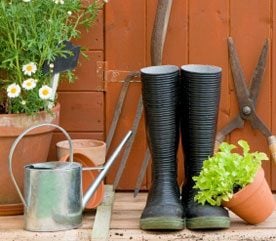Oct-Nov Backyard Garden Checklist
Winter is on its way-the days are shorter, the air is cooler, and plant growth has slowed or halted. Spend some time outside preparing your yard and garden for its rest by taking care of these routine end-of-season chores. It’ll give you a sense of accomplishment and closure, plus it’s important to protect all the time, money and effort you’ve invested.

Northeast
– Cut back tall perennials before the first frost. Chopping down to a few inches above the soil seems brutal, but it does no harm and allows for spring’s resurgence.
– Drain the hose and bring it in for winter. Wipe down with a rag, so there’s no mud or moisture on it. Store it flat, letting it coil naturally, someplace dry and dark.
– Close the compost pile for the winter. Its activity has been slowing for a while, and adding kitchen scraps to it now only leads to a pile of frozen garbage. Give it one last stir, and then replace the lid or cover it with a tarp.
– Spread a few inches of mulch (such as shredded autumn leaves or salt-marsh hay) over your flower beds after the ground freezes. This protects plant root systems from soil-temperature fluctuations and frost heaving.
– Shield your evergreens, particularly marginally hardy ones or ones with columnar forms that are growing in windy or exposed locations. Plywood tents are fine if the wood is not flimsy and you can secure them. Otherwise, a cage or burlap should do the trick.
Central
-Send broadleaf evergreens into winter in good shape. Water each deeply before the ground freezes. Once it does, you may choose to spray foliage with an antidesiccant product (follow label directions).
– It’s time to put the veggie garden to bed. Pull out and compost remaining plants, with the exception of anything that is diseased or pest-ridden (bag that up and send it away with your household trash).
-Renew the organic matter in garden beds before the ground freezes. Well-rotted, homemade compost is perfect, or buy bagged. Dig and mix everything to a depth of 6 inches or so.
– Empty window boxes now. Discard the soil mix, as well as the dead plants. Scrub out the interior with a brush, and wipe down the entire thing, inside and out.
– Since light is low this time of year, check that your houseplants are getting enough. They may need grooming or moving to a better, sunnier window. But don’t overdo water or plant food-for most plants, winter is a time of slower growth.
Northwest
– Evaluate your veggie garden and make notes for next year. Do you need more space for ramblers like zucchini? Did you have too many tomato plants? Store these notes where you will find them next spring.
– Plant cool-weather herbs, like parsley and chives. They grow quickly in still-warm soil and are watered by late-season rains.
– Have mushrooms sprouted in your lawn? Your best bet is to take a rake to them. Knock off their tops, and cart them away.
– Windy weather can be hard on your perennial climbing plants, including roses. Pay them a visit and make sure all major stems are secured to supports.
– Prepare perennials for the weather. Chop them back to within a few inches of soil level, then surround them with a few inches of protective mulch. Or leave them stand for winter interest and food for the birds.
Southeast
-It’s not too late to get in one last edible crop, if the ground is still workable. You can plant perennial types of onions (bunching onions, shallots). They don’t need special care; just give them a spot with decent soil. Water them deeply only if rainfall is sparse.
– Protect cold-sensitive or young plants in the yard if frost threatens by shielding the most vulnerable part of a plant, the growing tip. Just cover it with a large grocery store bag or old towel. Remove when danger is past.
– When you’re cleaning up and chopping back your perennials, spare a few that have winter value. Birds may enjoy the dried flower heads, either as a place to alight or as a food source.
– If you expect the ground to freeze, dig up healthy gladiolus corms. Dry them on screens for a week, then remove foliage and gently brush off the soil. Store uncovered in labeled bags in a dark, frost-free spot.
Southwest
– Small rodents and deer may nibble on young trees in your yard during the winter months. If they “girdle” a tree (strip away or destroy bark either part of or all the way around the trunk), it can die. Thwart these pests by putting a cylinder of hardware cloth around each tree and pressing it into the ground a few inches.
– Pick the last tomatoes, especially if frost threatens. Help partially ripe ones by placing them in a bowl with an apple. The ethylene gas that a ripe apple naturally emits hastens this process.
– Protect marginally hardy rosebushes. The grafted ones, in particular, have a hard time in cold weather and can die down to the rootstock. Shovel mulch over the base of each plant, up and over the bulging graft.
– If your garden is short on color, in-ground displays of cold-tolerant annuals like pansies are a fix. Or pot bulbs, caladiums or cyclamen on the front porch or patio. Protect them with mulch and coverings as needed.



